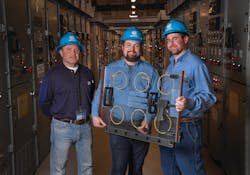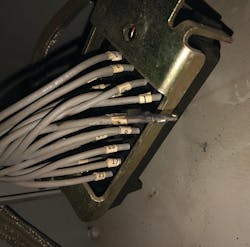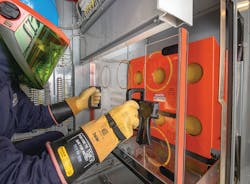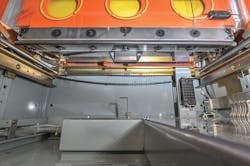Daily tasks in the electric utility industry expose workers to high energy and high risk. Several years ago, before I came to work for Consolidated Edison Company of New York, Inc. (Con Edison), a colleague of mine in Maryland lost his life when he accidentally made contact with an energized bus component. A loss of life is not something we ever really get over, nor should we. The team at Con Edison decided to do something about this type of safety hazard and developed the Cubicle Inspection and Repair Safety (CIRS) Device.
The CIRS Device is a nonconductive safety barrier installed in front of switchgear cubicle shutter assemblies to shield utility workers from danger. Testing and ongoing use have shown the device is effective in greatly reducing the risk of an accident or even a fatality.
Strong Safety Culture
Con Edison operates in a dense, urban environment unlike any other. The underground electric-delivery system contains 97,844 miles (157,165 km) of cable. It withstands extreme summer heat that causes load to soar and corrosive road salt in the wintertime that seeps into underground vaults and coats cables. Because New York is a city of islands, salty seawater flooding into the underground system also is a peril.
Joe Szabo, a senior engineer in the equipment and field engineering department, was concerned about recent operating incidents affecting Con Edison’s medium-voltage circuit breaker fleet and switchgear. He accurately concluded cubicle maintenance was a contributing cause. Acculturating dirt and dust can cause major issues and are easy to overlook in a cubicle.
Since work within those cubicles would require a bus section outage, potentially compromising system reliability, Con Edison and other similar utilities typically make repairs to fix damaged and failed components as they happen, instead of performing comprehensive cubicle preventive maintenance. This seems more efficient than taking what might be deemed an unnecessary bus section outage. The utility decided this type of thinking needed to be reevaluated along with its cubicle maintenance approaches.
Szabo and I set out to design a device that could be installed safely in a switchgear cubicle so mechanics could perform thorough inspections, preventive maintenance and repairs, without endangering themselves or risking outages to customers. Earlier attempts at creating inspection barriers were not switchgear specific and did not let the user fully access and inspect the cubicle components. It was impossible to operate the racking/shutter mechanism and safely perform a detailed visual inspection without de-energzing the switchgear bus.
Enter Matthew Johnson, a senior designer at Con Edison’s machine shop in the Van Nest area of the Bronx. He was tasked with all the engineering drawings and fabrication of the prototypes and became a key player in this effort. Johnson, Szabo and I worked on various designs and prototypes. After eight working prototypes, the team finalized a patent-pending design.
A diverse team of operators, mechanics, subject matter experts and safety specialists were involved in trials and testing. The driving guideline throughout the prototyping phases was safety by design. The team identified all potential hazards early on and took into consideration all the components inside a switchgear cubicle to make the installation and removal ergonomic and user friendly. Taking the strain off the user’s back and arms makes the overall installation easier and safer.
Numbers Tell the Story
According to the U.S. Occupational Safety and Health Administration, approximately 5000 workers throughout all industries died on the job in the U.S. each year between 2015 and 2018. Of those deaths, an average of 80 workers were electrocuted. These numbers are tragic and represent incredible suffering and sorrow for families, friends and colleagues. The goal is and always will be zero close calls, injuries and deaths in work settings where high-consequence risk is involved.
With the CIRS Device, a mechanic can safely perform inspections, preventive maintenance and corrective maintenance on most components within the cubicle without needing a bus section outage. The device consists of nonconductive, rigid components of polycarbonate, nylon and rubber. The three core components include a main shield, sliding panel and lower folding baffle. A simple clamping mechanism secures the device in place after installation.
Once installed, the large main polycarbonate fixed panel serves as the barrier in front of the cubicle shutter assembly, with reference circles to assist the user with placement and alignment in the cubicle. The right sliding panel ensures a smooth installation with the clamping mechanism that holds the device in place inside the cubicle. The lower/underside panel serves as additional barrier for the user to work safely on components where there is no Micarta board or insulation to provide isolation from the feeder tubes or bottles.
The majority of the components — such as the handles, clamping mechanism and sliders — are 3-D printed nylon made in Con Edison’s fabrication shop, off-the-shelf nylon and rubber hardware. Plans for larger production methods will include vacuum cast or plastic injection-molded components for increased strength, durability and cost-efficient manufacturing.
The final proof of concept underwent various testing, including a simulated worst-case arc-flash scenario, before the product rollout. The team conducted several fitment tests in training cubicles in the Con Edison system to ensure the device would fit, as cubicles vary in dimension because of different original equipment manufacturers and retrofits. The team ensured the components could handle the rugged environment of utility work and collaborated with users and subject matter experts to ensure the device was the best it could be. Most importantly, team members ensured the material properties, in a worst-case event, would not add to the heat and force of an arc flash. The team garnered support from Con Edison Senior Research Engineer Sergo Sagareli, who brought the device to DNV GL Laboratories in Chalfont, Pennsylvania, for testing in a 63-kA arc-flash event. The purpose was to ensure the CIRS device would sustain the heat and force of a high-energy arc flash and not become shrapnel itself.
In Chalfont, two tests were performed. The CIRS Device was installed in a GE PowerVac switchgear cubicle with a mannequin (dressed in Con Edison-issued flame-resistant coveralls, hard hat and gloves) simulating a mechanic performing corrective maintenance. For both tests, a 63-kA fault was generated by tying the three phases of test bus together with bonding wire. For the cubicle test, the test bus was connected to the cubicle bus components. For the open-air test, the test bus was behind the CIRS Device, which was stood up and tied down to jersey barriers. Both tests exposed the device (as well as the cubicle and mannequin for one of the tests) to >63-kA flash for an approximate 94-msec six-cycle duration.
The team chose the 63-kA level because it is Con Edison’s short-circuit rating for substation equipment. As a result, the energy from the arc flash was approximately 7 MJ. The three main panels eventually separated, but the polycarbonate components remained intact under the extreme heat and force. The device even absorbed much of the heat and molten metal from the arc flash.
The tests demonstrated the CIRS Device protects the user from accidental contact that could occur if there is as much as a hairline crack in a ceramic feeder tube that exposes the user to energized bus work.
CIRS Device in Use
Taking a bus section out of service requires significant effort and time. To confirm a cubicle is safe, workers must trip the bus section and verify it is de-energized and grounded. They also must perform de-loading and field switching to maintain reliability to customers. For stations feeding a network system, each feeder cable is alive on back-feed until it is intentionally grounded, and all secondary network protectors are tripped. The network protectors must each be manually reset; every move has its own inherent avoidable risk.
The first documented use of the CIRS Device was in January 2019 at a Con Edison 13-kV substation in Westchester, New York. A 13-kV bus section was out of service as a result of a transformer replacement. The operator received orders to restore the bus section by racking in and closing the tie circuit breaker. While performing this work, the operator was not able to close in the breaker safely, as it would not electrically charge. The circuit breaker was removed from the cubicle and the mechanics found the secondary block was damaged and needed repair.
Without the CIRS Device, the repair would have required an extensive bus section outage. This would have meant 24 hours to 36 hours of field switching (de-loading, tying and separating circuits) and another 40 hours of substation support (switching and repairs). With four feeders already out of service, this additional outage would have increased the count to an unacceptable total of seven unavailable feeders. The CIRS Device served as a safe solution for Con Edison to make repairs without risking system reliability.
Used in more than 15 corrective maintenance activities in 2019, the device enabled the utility to avoid the potential for injury, bus section outages and significant operating expenses. Recent use of the CIRS Device for corrective maintenance has saved US$5000 to $50,000 in operating expenses per use, depending on the case. Those costs can hit numerous budgets throughout the utility and include system analysis, de-loading, switching support, repairs and restoration.
Sky's the Limit
The CIRS Device initially was designed for GE PowerVac and Powell Industries Power/Vac applications, but it is scalable. Simple modifications of the dimensions make it adaptable to any make, model, voltage and current rating application. Con Edison is rolling out the next-generation CIRS Device for the Hyundai HVF medium-voltage application and fit testing the next device for use in the GE MagneBlast switchgear.
Con Edison’s goal always has been and continues to be the improvement of safety and work practices, including ensuring its employees and anyone working in switchgear cubicles can work safely every day, every time, in every situation. The CIRS Device has become another valuable tool to help Con Edison employees perform inspections and preventive maintenance safely, resulting in long-term equipment performance improvements without compromising system reliability.
For more information:
DNV GL Laboratories | www.dnvgl.com
GE | www.ge.com
Hyundai | www.hyundai-electric.com
Powell | www.powellind.com
About the Author
Eric M. Fell
Eric M. Fell is a senior safety specialist in environment, health, and safety at Con Edison, working on the development, analysis, and implementation of safety technology to reduce injuries and strive toward a zero-harm environment. He brings a wealth of knowledge from his experience throughout the industry as a substation operations and maintenance supervisor and a field engineer.





